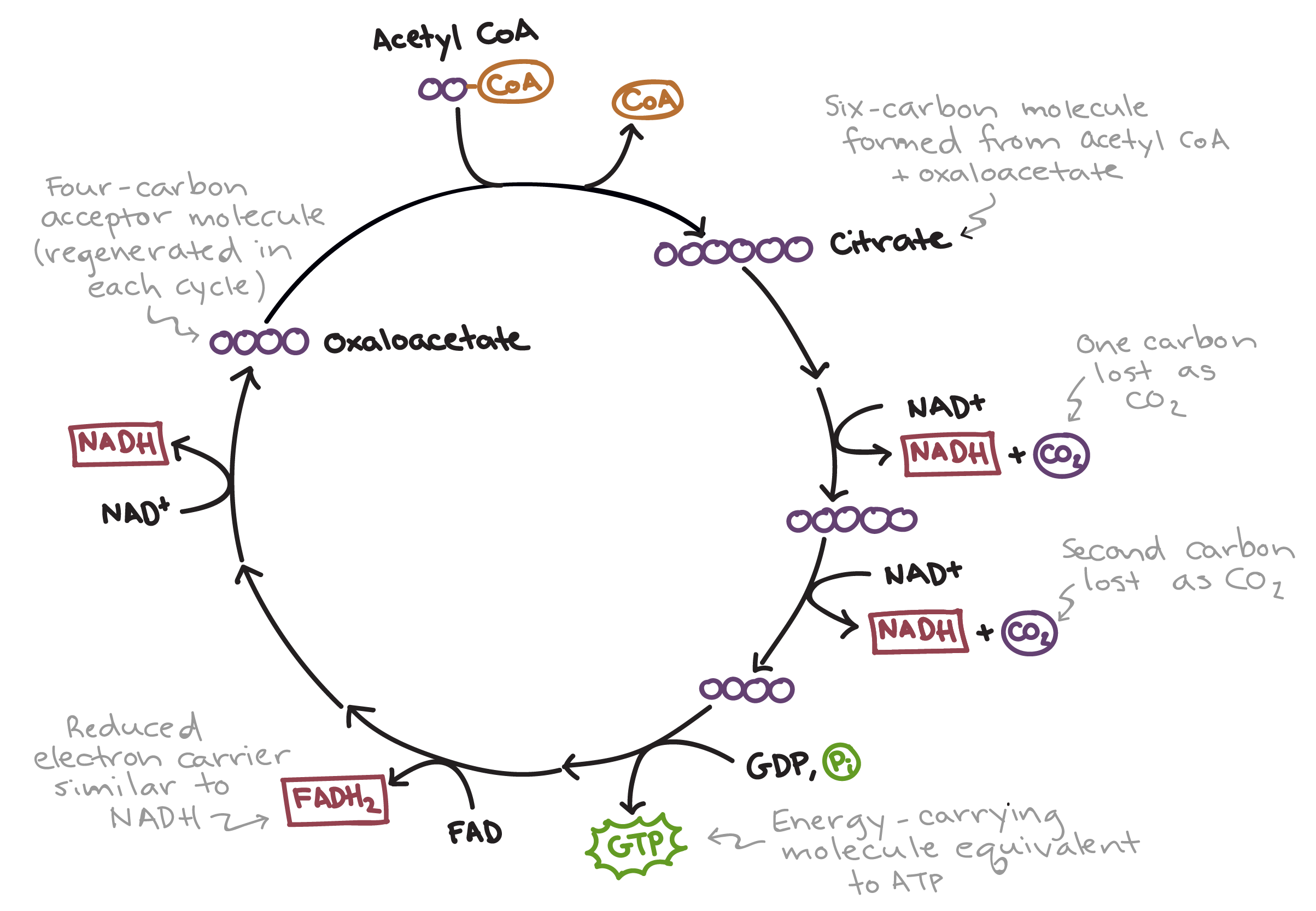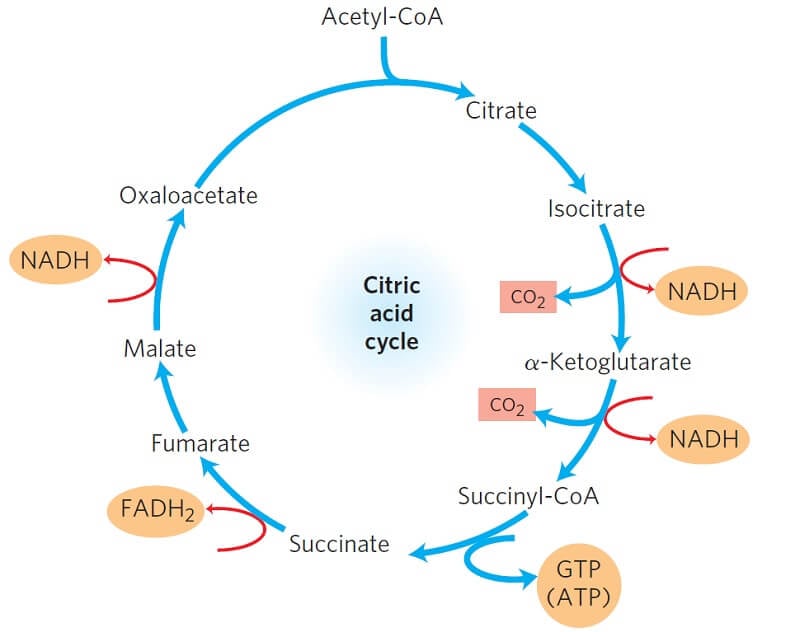Describe the Krebs Cycle in Your Own Words
Since the end results of glycolysis are 2 pyruvates the Kreb cycle goes through 2 cycles in order to make 2 ATP in total 1 ATP for each of the 2 pyruvates. In 1937 a man by the name of Albert Szent-Györgyi was studying pigeon muscles.

Krebs Cycle Made Easy Krebs Cycle Simple Animation Carbohydrate Metabolism Lesson Youtube
The reactions which help in converting pyruvic acid to carbon dioxide and water in mitochondria are called the Krebs cycle.

. Lyrics and a handy chart depicting the cycle. The Krebs cycle takes place in the matrix of mitochondria under aerobic conditions. Directly because the Krebs cycle makes 1 ATP molecule for every 1 pyruvate.
Glycolysis the Krebs cycle and oxidative phosphorylation. We can divide cellular respiration into three metabolic processes. In the first reaction of the citric acid cycle acetyl CoA combines with the oxaloacetic acid to form citric acid.
So the Krebs cycle makes 2 ATP in two cycles of Krebs and glycolysis makes 2 ATP. Following glycolysis the mechanism of cellular respiration involves another multi-step processthe Krebs cycle which is also called the citric acid cycle or the tricarboxylic acid cycle. The song is on Track 10 of their first album Muscles Magnets.
The Krebs cycle is simply another name for the Citric Acid Cycle so named for the researcher who identified the complete cycle in 1937. Efficient in an oxyg Read more. Stay with me now.
In plants and animals eukaryotes these reactions take place in the matrix of the mitochondria of the cell as part of cellular respiration. Whether youre a student teacher homeschooler principal adult returning to the classroom. Carbon dioxide is also released as a waste product of these reactions.
It is also known as the citric acid or tricarboxylic acid cycle TCA cycle. The reaction is catalyzed by citrate synthase. The cycle occurs in the mitochondria of cells using 2 molecules of pyruvic acid from glycolysis to produce the energy molecules.
The cellular respiration is the process by which glucose is broken down and produce metabolic energy. They extremely vary in. The Krebs cycle uses the two molecules of pyruvic acid formed in glycolysis and yields high-energy molecules of NADH and flavin adenine dinucleotide FADH 2 as well as some ATP.
In all plants and animals a series of enzymatic reactions in mitochondria involving oxidative metabolism of acetyl compounds to produce high-energy phosphate compounds that are the source of cellular energy. In the Calvin cycle several anaerobic chemical reactions occur that allow plants to transform the carbon from CO 2 into sugars. The first step is the condensation of acetyl CoA with oxaloacetate 4C to form citrate 6C coenzyme A is released.
And Answers Velocity Worksheet. It is an eight-step process. Download the Science Groove MP3.
Describe the Krebs Cycle in Your Own Words Until the Krebs cycle aerobic respiration can be described without mentioning oxygen the chemical. Overall the Krebs cycle provides energy and heat for the bodys many processes and the mitochondria are key to this process. Enzymes primarily involved in glycolysis and in the Krebs cycle showed only a small rise in activity.
Describe in your own words the function of the Krebs cycle. This is why the Krebs cycle is also called the citric acid cycle. Krebs cycle The Krebs cycle also known as the citric acid cycle or the tricarboxylic acid cycle is one of the most important reaction sequences in biochemistry.
Cells also gain 2 ATP at the end of one cycle of glycolysis. A sequence of reactions in the living organism in which oxidation of acetic acid or acetyl equivalent provides energy for storage in phosphate bonds as in ATP called also citric acid cycle tricarboxylic acid cycle. Krebs cycle citric Acid cycle releases plenty of energy ATP required for various metabolic activities of cell.
By this cycle carbon skeleton are got which are used in process of growth and for maintaining the cells. After those sugars are formed the Krebs cycle begins. Definition of Krebs cycle.
This transfers high energy molecules and makes it so that citric acid is the first molecule formed. Discover how the Krebs cycle works. Definitions of Krebs cycle.
Not only is this series of reactions responsible for most of the energy needs in complex organisms the molecules that are produced in these reactions can be used as building blocks for a large number of important processes. The energy is captured in molecules of NADH ATP and FADH 2 another energy-carrying compound. Yes you heard that correctly.
The citric acid cycle also known as the Krebs cycle or tricarboxylic acid TCA cycle is a series of chemical reactions in the cell that breaks down food molecules into carbon dioxide water and energy. Krebs citric acid cycle citric acid cycle tricarboxylic acid cycle. The Krebs cycle also known as the citric acid cycle or tricarboxylic acid cycle is part of a series of chemical reactions that organisms use to break down food into a form of energy that cells can use.
After citric acid forms it goes through a series of reactions that release energy. Someone namely Lynda Jones of the band Science Groove has come to your rescue by putting the basics of the Kreb Cycle to music. Many bacteria perform the.

Krebs Cycle Citric Acid Cycle Tca Cycle With Steps And Diagram

The Citric Acid Cycle Cellular Respiration Article Khan Academy

No comments for "Describe the Krebs Cycle in Your Own Words"
Post a Comment